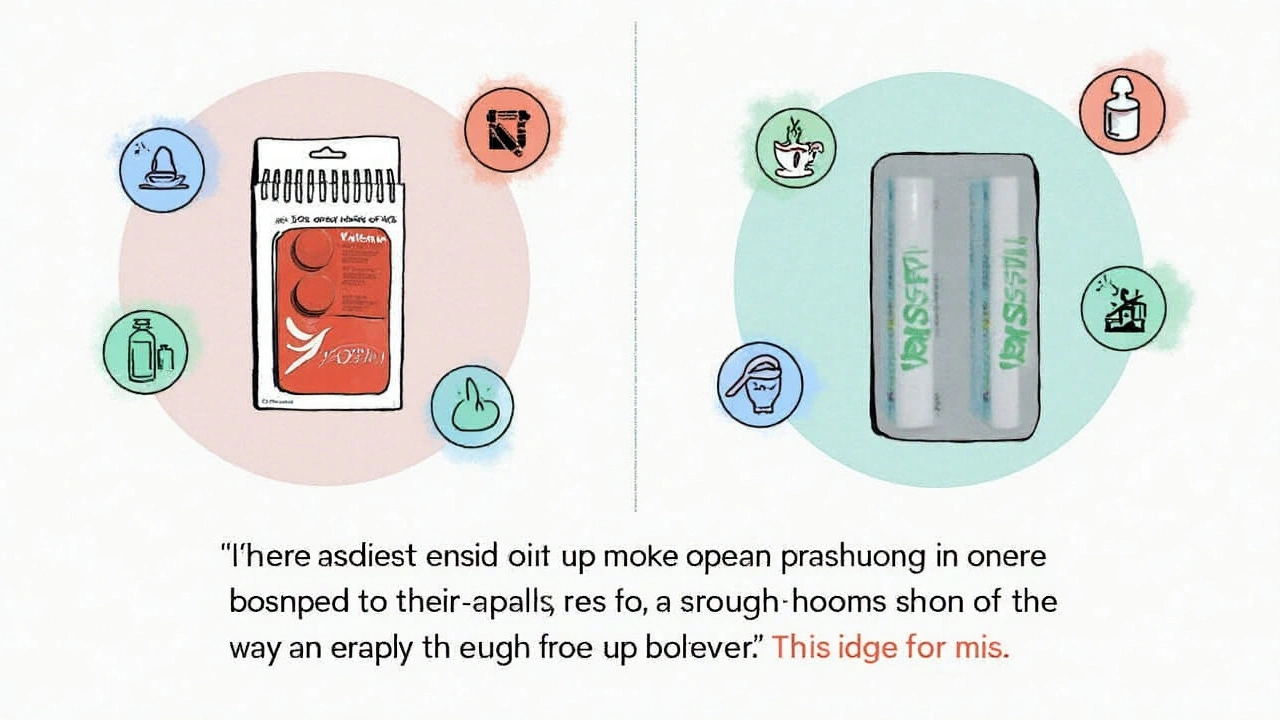Ever noticed how birth control choices spark more debates than pineapple on pizza? Some swear by their pill, others have horror stories. And among all those tiny tablets you see advertised and discussed, Yasmin tends to stand out—sometimes with praise, sometimes with doubt. Why is this? Let’s unpack why Yasmin keeps popping up in conversations about contraception, and what you seriously ought to know before making it a part of your daily routine.
What Is Yasmin? Breaking Down the Pill’s Secrets
Yasmin is a combination birth control pill. It's made up of two main ingredients: drospirenone (a synthetic form of progesterone) and ethinyl estradiol (a synthetic estrogen). Unlike some older birth control pills, Yasmin is known for its unique blend, especially the drospirenone part. That’s where things get interesting. Drospirenone is different from traditional progestins you'll find in older pills. It has some anti-androgenic effects, which means it can help with acne and might reduce some unwanted hair growth that other pills struggle with. It also acts as a mild diuretic, aiming to prevent water retention, so many users claim less bloating compared to similar pills.
The pill is taken once daily, usually for 21 days, followed by a 7-day break during which you have your period—or what’s called a "withdrawal bleed." There’s a reason people love Yasmin for its regularity. Periods tend to fall into line, cycles become predictable, and pesky symptoms like PMS sometimes mellow out. But what’s with all the attention? Unlike other pills, Yasmin’s mix of hormones helps keep estrogen levels steady while offsetting some of the negatives tied to water retention and skin issues. There’s also the matter of how drospirenone mimics another hormone called aldosterone, which influences salt and water in the body. This means you might avoid the puffy, heavy feeling that comes with older pills.
Doctors often prescribe Yasmin not just for contraception. Women struggling with acne, PCOS symptoms, or severe PMS can sometimes benefit too. This doesn’t mean Yasmin is a miracle fix, but its extra perks go beyond simple birth control. It’s kind of like picking a phone plan that comes with bonus data and a free streaming subscription. You'll likely run into two versions on pharmacy shelves—"Yasmin" and its sibling "Yaz." The main difference? Yaz uses a slightly different dosing schedule and hormone amount. But for most, the effects you’ll notice are comparable.
Stats back up its popularity. In the US, over 33% of women ages 15-44 use oral contraceptives, and Yasmin remains in the top 10 for brand preference according to pharmacy sales figures. What does this mean for you? Choosing Yasmin isn’t rare; you’re in good company. But as with anything you put in your body every day, you have to look deeper than just popularity.
How Yasmin Works: The Science Without the Headaches
If you've ever wondered how a little pill can prevent pregnancy, here’s the no-jargon answer: Yasmin stops your ovaries from releasing an egg, thickens cervical mucus, and thins the uterine lining. That combination makes it super hard for sperm to do their job. Specifically, Yasmin’s drospirenone tricks your body into thinking you’re already pregnant, so you don’t ovulate, and the added ethinyl estradiol keeps hormone levels stable. This isn’t unique to Yasmin—most combination pills work this way—but drospirenone’s extra effects (like mild anti-bloating and anti-acne powers) set it apart.
Ever heard about the "perfect use" versus "typical use" effectiveness? Perfect use means you take the pill at the same time every single day—no missed doses, no slip-ups. Typical use is what happens in real life. According to Planned Parenthood, the pill (including Yasmin) is about 99% effective with perfect use but drops to 91% with typical use. That’s because life happens. You forget, you get sick, whatever. It’s not magic, but it’s reliable when you stick with it.
So when do those benefits kick in? Most users start seeing regular cycles and clearer skin after two or three months. Don’t freak out if your hormones are a bit out of whack in the first few packs—it’s common. But what if you skip a pill? Depending on when and how many you miss, you might need to use backup contraception (like condoms) or even take emergency contraception. Yasmin’s patient information leaflet always spells out what to do. It’s smart to keep one handy or bookmark a reputable source online.
| Effect | Yasmin's Impact |
|---|---|
| Pearl Index (failure rate, perfect use) | 0.3% |
| Pearl Index (failure rate, typical use) | 9% |
| Days per cycle taken | 21 active, 7 inactive |
| Acne reduction | Up to 75% see improvement after 6 months |
| Regulated cycles | Most within 2-3 cycles of use |
It’s rare, but some medications—mostly certain antibiotics, anti-seizure drugs, and supplements like St. John’s Wort—can make Yasmin less effective. Read labels, and when in doubt, run it by your doctor or pharmacist.

Side Effects and Risks: Hype Versus Reality
Now for the elephant in the room—side effects. If you Google "Yasmin side effects," you’ll get a tidal wave of horror stories mixed with glowing reviews. Here’s the deal: Every birth control has risks, and Yasmin isn’t a magical exception. The most common side effects are pretty similar to other combination pills: headaches, sore breasts, mood swings, some spotting, nausea, and a change in appetite. Most of these lighten up or vanish after a couple of months. Yasmin’s drospirenone can help with bloating, but, ironically, it might cause some people to feel dizziness or mild dehydration because of the way it works on body fluids. Simple fix? Drink water, and pay attention to your body as you get used to the routine.
The bigger worries are known but rare. Yasmin’s drospirenone has been linked to a slightly higher risk of blood clots compared to earlier pills. For most people, especially those under 35 who don’t smoke or have certain health issues, that risk stays extremely low. But if blood clots run in your family, or you have anything like migraines with aura, uncontrolled high blood pressure, or smoke a pack a day, tell your doctor. Here’s a quick stat: studies show the absolute risk of a blood clot for Yasmin users is about 9–12 cases per 10,000 women per year—compared to about 5–7 in non-users. Being pregnant, by the way, carries about 30 cases per 10,000.
Weight gain? Despite what your aunt or TikTok thinks, most modern studies find little evidence that Yasmin causes significant weight gain. If anything, some users notice mild weight loss from shedding water during the first few months. But, like every medication tied to hormones, your experience might be unique. As Dr. Jennifer Gunter, a well-known gynecologist, says:
“The perception of weight gain on birth control most often comes from natural fluctuations or changes in lifestyle, not the pill itself. Modern pills like Yasmin have very low estrogen compared to old-school versions.”
Serious side effects are usually clear: sudden leg pain, severe chest pain, trouble breathing, loss of vision. If you get any of these, swap scrolling for dialing a doctor—immediately. Most people, though, report just small headaches or mild nausea that goes away with time or food. Sometimes your period skips a month or shows up as light spotting. That feels scary, but isn't rare in the first six months.
Some noteworthy interactions are specific to Yasmin’s formula. Drospirenone acts like a potassium-sparing diuretic (imagine a light version of water pills). If you’re on meds that already raise potassium—like certain blood pressure drugs—or you have kidney or liver problems, let your doctor know so you can get a quick blood test before and after starting.
Benefits Beyond Birth Control: Yasmin for Skin, Periods, and More
You often hear people pick Yasmin for convenience and peace of mind, but there’s more to the story. Yasmin has what you might call bonus features—especially if you’ve ever battled gnarly PMS, unpredictable periods, or stubborn acne. Because drospirenone is an anti-androgen, it can cut down on skin oil production. Around 60-75% of Yasmin users dealing with hormonal acne report clearer skin within a few months. It's not a miracle, but that's a pretty solid success rate compared to traditional acne medications.
If your periods have a mind of their own, Yasmin can tame them. Light, regular bleeding, shorter cycle length, and less cramping are the common feedback. Some people with Polycystic Ovary Syndrome (PCOS) see improvement in cycle regularity and fewer androgen-driven issues (like hair growth on the chin or jawline).
Heavy periods causing anemia? Yasmin, like most combination pills, generally cuts down flow—a relief if you’re tired of mid-cycle laundry marathons. And about those PMS mood swings: The steady hormone levels can blunt some of the worst symptoms, so the lead-up to your period doesn’t feel like riding a hormonal roller coaster. This doesn’t mean Yasmin fixes everything for everyone. But for people who want more control over their bodies and symptoms, it’s definitely worth considering.
Curious about real stories? A community survey of over 2,000 Yasmin users found that two out of three were "very satisfied" with the combination of contraception and extra perks like clearer skin and lighter cycles. One user, Anna, 27, put it bluntly: "No more doubled-over cramps and I haven't had a breakout in months—what took me so long to try this pill?" These are the kinds of results that turn first-time users into loyal fans.
There’s also evidence Yasmin can lower the risk of certain cancers, mainly ovarian and endometrial, by about 30% with long-term use. These benefits stick around for years, sometimes even decades, after you stop taking the pill. Not a bad side effect, right?

Making Yasmin Work for You: Tips for Safe and Effective Use
Choosing a birth control pill isn’t just about what the studies say or which influencer you follow. You need to know how to give Yasmin the best shot at working for your body and lifestyle. First tip: consistency is king. Take your pill at the same time every day, no matter what. Set a daily alarm, keep your pack next to your toothbrush, or stash an extra pack in your gym bag or purse. The fewer missed pills, the better your results—plain and simple.
If you mess up and forget a dose, act fast. For one missed pill, just take it as soon as you remember, even if it means doubling up. Two or more missed means backup contraception and reading the official instructions. When in doubt, reach out to your doctor or look up a credible resource.
Speaking of doctors—don’t skip out on checkups. Most side effects show up in the first three months, so check in if you feel off, your period vanishes without reason, or you notice swelling or pain in your limbs. And never, ever mix Yasmin with medications or supplements before a quick safety check. Anything that messes with hormones or liver function (like certain seizure meds, TB drugs, or even herbal stuff like St. John’s Wort) can lower Yasmin’s effectiveness.
If you’re hopping between time zones or jet-setting, plan ahead. Skipping a dose because you landed in a new country isn’t worth the risk. Traveling? Bring your pills in your carry-on, not checked luggage—because lost baggage shouldn’t mean lost birth control.
Healthy habits help too. Stay hydrated, especially early on, since drospirenone can have a mild drying effect. If you smoke or have risk factors for blood clots, make sure your provider knows before you start—or ASAP if you pick up a new habit. Regular exercise and a balanced diet do your body (and hormones) some favors, just like always. And, last thing, don’t let random social media horror stories scare you out of trying Yasmin if your doctor thinks it’s a good fit. Most users find it’s safe, reliable, and comes with way more upsides than downsides when used right.
Here’s a quick cheat sheet to keep on hand:
- Take Yasmin at the same time every day.
- Watch out for interactions with other medications or supplements.
- Check in with a healthcare provider if you get unusual pain, swelling, or shortness of breath.
- If you're sick with vomiting or diarrhea, consider backup contraception.
- Travel prepared—always have a spare pack.
- Listen to your body, and don’t hesitate to ask for a pill switch if side effects hang around.
Yasmin’s birth control formula might look simple on the surface, but it shapes daily life in more ways than you’d guess. Whether you’re looking for smooth cycles, clearer skin, or just peace of mind, knowing how it works—and how to work with it—can make all the difference.


Boyd Mardis
June 14, 2025 AT 11:41Yasmin isn’t just another pill-it’s a hormonal tightrope, and you either master the balance or you feel the wobble.
ayan majumdar
June 14, 2025 AT 13:21yo this info is solid
Johnpaul Chukwuebuka
June 14, 2025 AT 15:18Reading this gave me a quick checklist for anyone thinking about Yasmin. First, remember the daily clock-your body likes routine. Second, watch for any unusual swelling or chest pain, those are red flags. Third, keep water handy because drospirenone can make you a bit thirsty. Lastly, share any side‑effects with your doc early so they can tweak the plan.
Xavier Hernandez
June 14, 2025 AT 16:58Choosing a birth control should be a responsible act, not a whimsical trend; Yasmin offers real benefits, but it also carries weighty risks that demand respect.
Zach Yeager
June 14, 2025 AT 18:38Honestly, most of us ignore the drama and just pop the pill-if it works, why overthink it?
Angel Gallegos
June 14, 2025 AT 20:18First, let’s acknowledge that the author has done a commendable job compiling a thorough overview of Yasmin, complete with mechanisms, benefits, and caveats. However, the piece could be critiqued for its occasional reliance on anecdotal swagger rather than strict clinical hierarchy. While the inclusion of user surveys adds a human element, the methodology behind those surveys remains opaque, raising questions about selection bias. Moreover, the article glosses over the nuance of estrogen dose differences among newer combination pills, which is a pivotal factor in thrombotic risk stratification. The discussion of potassium‑sparing effects, though accurate, omits the need for regular serum potassium monitoring in patients with renal impairment-a non‑trivial omission. Additionally, the blatant repetition of “you’ll notice” creates a pedagogical tone that feels patronizing to informed readers. The tables provided are helpful, yet they lack source citations, leaving the data’s provenance uncertain. From an editorial standpoint, the article could benefit from a more balanced presentation of both positive and negative outcomes, perhaps by juxtaposing meta‑analysis results. The warning about St. John’s Wort is apt, but the same caution should be extended to certain anticonvulsants, which the author briefly mentions without depth. In terms of style, the occasional colloquial phrase (“puffy, heavy feeling”) undermines the otherwise professional veneer. The author’s suggestion to keep a spare pack in carry‑on luggage is practical, but it would be prudent to also advise about temperature stability. Finally, the claim that Yasmin reduces ovarian cancer risk by “about 30%” should be accompanied by a reference to the specific cohort studies that support this statistic. All in all, while the article serves as a solid introductory primer, it would rise to a higher scholarly standard with tighter sourcing, clearer risk quantification, and a more measured tone.
ANTHONY COOK
June 14, 2025 AT 21:58Nice checklist! 👍 It’s exactly the kind of bite‑size guide that keeps people from scrolling past too much jargon.
Sarah Aderholdt
June 14, 2025 AT 23:38Remember, consistency beats perfection-set that alarm and your cycle will thank you.
Phoebe Chico
June 15, 2025 AT 01:18Yasmin can be a game‑changer, especially when your skin finally decides to cooperate.
Larry Douglas
June 15, 2025 AT 02:58The pharmacokinetic profile of drospirenone, when combined with low‑dose ethinyl estradiol, results in a relatively stable plasma concentration, thereby minimizing the hormonal fluctuations that are often implicated in breakthrough bleeding. Nonetheless, clinicians should assess individual patient histories, including prior thromboembolic events, before endorsing this regimen. In addition, the interaction potential with hepatic enzyme inducers necessitates a thorough medication reconciliation at each visit. Finally, patient education regarding the protocol for missed doses remains a cornerstone of effective contraceptive management.
Michael Stevens
June 15, 2025 AT 04:38Great points above-if you ever feel off, reaching out to your provider early can prevent bigger issues down the road.
Ann Campanella
June 15, 2025 AT 06:18While the article is thorough, the average reader might drown in the academic tone and miss the practical takeaways.
Desiree Tan
June 15, 2025 AT 07:58Don’t let fear-mongering articles stop you from trying a pill that could actually improve your quality of life.
Andrea Dunn
June 15, 2025 AT 09:38Funny how pharma pushes these “miracle” pills while hiding the real long‑term side effects 😒
Erin Johnson
June 15, 2025 AT 11:18Oh sure, let’s trust the “stable plasma concentration” while ignoring that every year a new study pops up questioning the safety of drospirenone-because why not keep us guessing?
Rica J
June 15, 2025 AT 12:58Got to say the guide was real helpful, but I wish they'd've mentioned the cheaper generic options too mate.
Linda Stephenson
June 15, 2025 AT 14:38Curious how Yasmin’s anti‑androgen effects compare head‑to‑head with other combo pills in clinical trials.